.png)

Glucosamine for Dogs
Sections

Complete Guide on Glucosamine for Dogs
“Do you wanna go for a –”
Your dog’s ears prick up, and he tilts his inquisitive face to one side. His eyes are bright and hopeful. He’s waiting for that special word.
“– WALK?!”
Delightful chaos erupts. Your canine companion leaps joyfully, yapping excitedly, and runs for the door. He’s ready for his next adventure with you.
But what would you do if, one day, your dog can’t get up?
One in five dogs experience joint and muscle problems. From arthritis to hip dysplasia, joint problems are physically painful for your precious pup and hugely detrimental to their wellbeing as it affects their mobility.
Luckily, there are solutions available to protect your dog from the onset of joint problems and even to reduce the painful symptoms of existing conditions.
Glucosamine is a powerful natural substance that repairs the precious cartilage protecting your pet’s joints. When given in its most potent form and when combined with other ingredients, even arthritic senior dogs can be given a new lease of life.
But, with so many products out there promising life-changing results with sub-par ingredients, knowing how to find the right supplement can be difficult.
That’s why we’ve compiled the ultimate guide to glucosamine for dogs.
In this comprehensive resource, you’ll finally be able to understand what glucosamine is, how it can help your dog, and where you can find the best possible source of it to start seeing results.
TRI-ACTA H.A. for Pets
Our maximum strength formula is optimally designed to accelerate the formation of cartilage, minimize inflammation, expedite the healing process, and improve joint conditions.
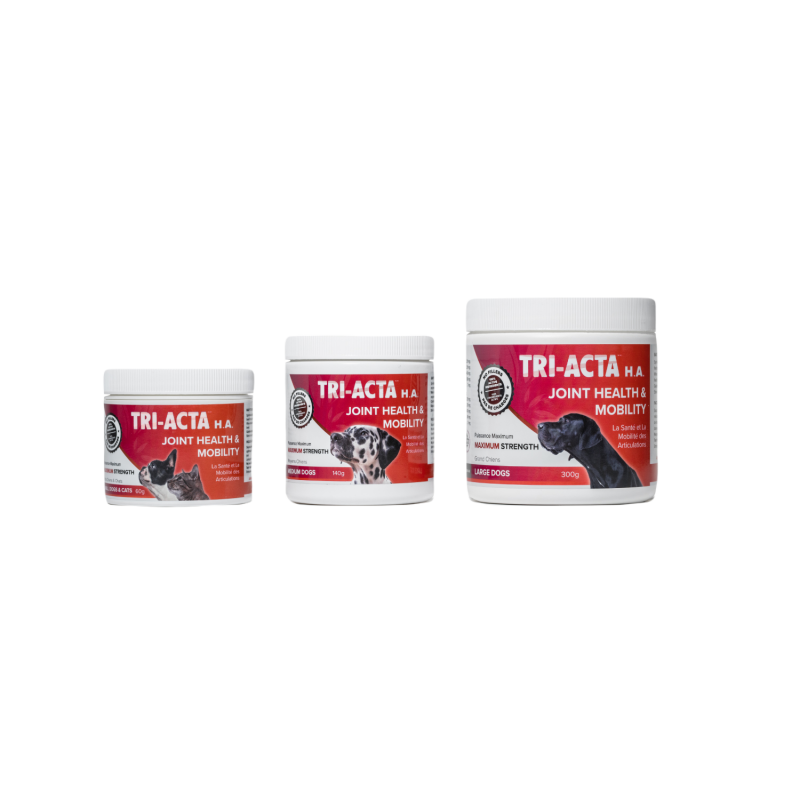

What Is Glucosamine for Dogs?
Glucosamine is a naturally occurring chemical compound in the body responsible for the upkeep of healthy cartilage. Cartilage is the rubbery stuff between your dog’s bones that protects and supports your joints.
Sadly, as your dog ages, the cartilage wears thin due to decreased glucosamine production.
Connective tissues within ligaments can become brittle and rigid as time goes on, causing stiffness in the joints. Larger or overweight animals may experience faster cartilage degeneration because their weight adds pressure on the joints, increasing wear on the cartilage, tendons, and ligaments.
The last thing any of us want is for our dogs to be in a state of constant discomfort. Luckily, we can aid in the repair or proactive care of cartilage in dogs.
The Two Types of Glucosamine For Dogs
Glucosamine and chondroitin are two of the most important components in joint health for dogs:
- Glucosamine is an amino sugar naturally produced by the body. It acts to repair cartilage by providing the necessary building blocks for its formation.
- Chondroitin inhibits and neutralizes destructive enzymes in the joint. By doing so, it helps prevent the breakdown and deterioration of cartilage.
In supplement form, glucosamine is harvested from the exoskeleton of shellfish shells. If your dog has a shellfish allergy, there are forms of glucosamine for dogs made in labs without animal products.
Glucosamine most often comes in two forms:
- Glucosamine Sulfate: Delivers sulfur to your dog's joints, a crucial component that aids in maintaining and repairing joint structures.
- Glucosamine Hydrochloride: Glucosamine HCl is a highly bioavailable form of glucosamine, which allows for quicker and easier absorption by your dog's body. As a result, your dog's joints can experience enhanced lubrication and protection more rapidly.
Glucosamine vs. Green-Lipped Mussel for Dogs

Glucosamine provides many positive benefits for dogs, including aiding in cartilage repair and enhancing lubrication of the joints, allowing for easier movement. But there is another popular supplement that dog owners may consider called green-lipped mussel powder.
Green-lipped mussels are a sea creature native to New Zealand. The animal is processed into a capsule, powder, tablet, or incorporated in dog food to provide anti-inflammatory benefits. Evidence suggests that giving dogs green-lipped mussels can improve conditions like osteoporosis and general joint degradation.
Here is a table that compares the differences between glucosamine and green-lipped mussel for dogs:
|
Green-Lipped Mussel for Dogs |
Glucosamine for Dogs |
|
|
Sustainability of Green-lipped Mussel for Dogs
You might not immediately think of environmental protection when looking to alleviate your dog’s inflammation. However, it becomes relevant when considering sources like green-lipped mussels, which are native only to the coastal and intertidal zones of New Zealand.
These mussels are not only valued for their rich fatty acid and protein content while being low in fat, making them attractive for aquaculture, but they also necessitate careful farming practices. The New Zealand government enforces stringent regulations and monitoring to prevent any adverse environmental impact from mussel farming.
Despite successful regulation, those who are cautious about potential negative effects on marine ecosystems might want to explore alternative options, such as synthetically produced MSM, to avoid contributing to ecological stress.
Forms of Glucosamine for Dogs
Glucosamine for dogs comes in a variety of different forms, including powders, liquids, chews, and capsules. Each form has its own pros and cons.
Glucosamine Powder for Dogs

Powdered glucosamine products are often the easiest to administer to your dog because they can be easily mixed into wet or raw food or even sprinkled on top of kibble. Because the dosage is usually quite low, the chances of your dog noticing the glucosamine is slim. TRI-ACTA products, for instance, are completely flavourless.
TRI-ACTA for Pets
A proactive approach for developing and younger adult pets to maintain optimal joint health mobility, minimize inflammation and fend off age-related ailments.
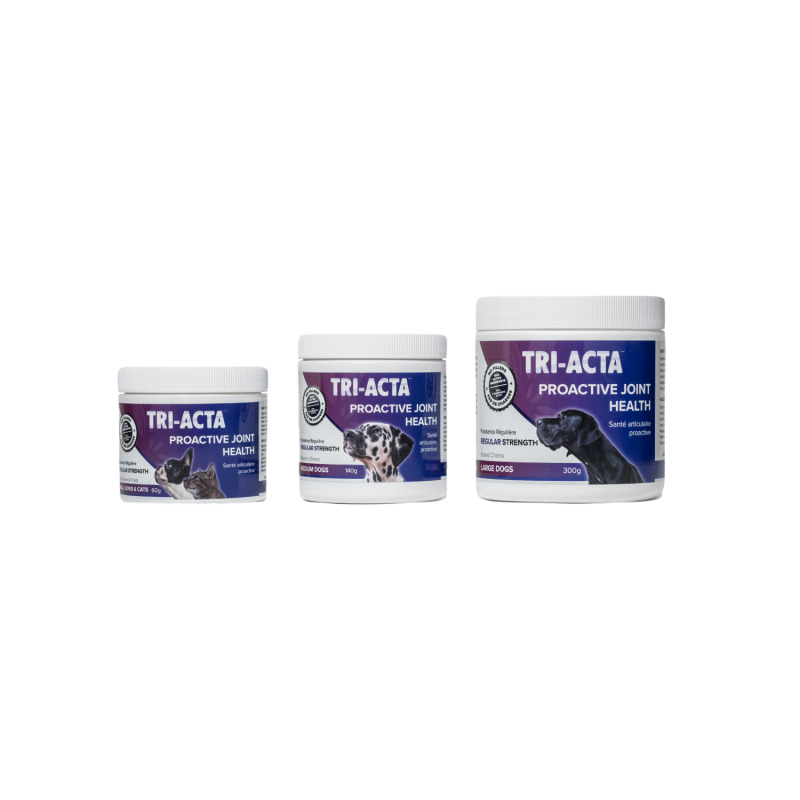
Liquid Glucosamine for Dogs
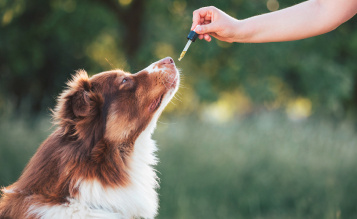
Liquid glucosamine for dogs is also an option. Administering these liquids might be somewhat challenging, as it typically requires using a syringe to measure and extract the correct dosage from the bottle, a process that can become increasingly difficult as the bottle nears emptiness.
Additionally, these supplements frequently include extra components such as fish oil, which enhances both the flavor and the health benefits, targeting joints and digestion. However, the fishy taste might not appeal to all dogs, and the presence of multiple ingredients raises considerations regarding potential allergies or adverse reactions.
Glucosamine Chews for Dogs
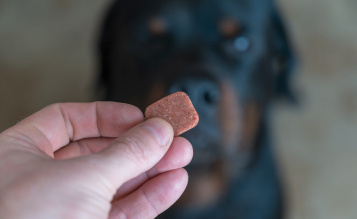
Chewable glucosamine supplements for dogs are typically available as flavored tablets or treats.
These chews are designed to resemble real treats, making them theoretically one of the simplest types of joint supplements to administer, as dogs are generally eager to accept them. However, since these chews are formulated to be treat-like, they invariably include fillers, additives, and preservatives. Additionally, these glucosamine chews for dogs contribute extra calories to your dog's diet, which might not be desirable.
Capsule Glucosamine for Dogs

Capsule dog joint supplements are less commonly found on the market, likely due to the challenges involved in administering them. Many dogs are reluctant to take pills and often detect the capsule hidden in food, such as cheese, skillfully avoiding it while still consuming the treat. Furthermore, many of the capsule supplements available require administering multiple capsules per dose, which complicates the process even further.
Here is a table that summarizes the differences between the four main types of glucosamine supplements for dogs:
|
Type of Glucosamine for Dogs |
Administration |
Other Notes |
|
Powder |
Easily sprinkled on top of wet, dry, or raw food |
|
|
Liquid |
Requires a syringe to draw the correct dosage of liquid; can make dry food soggy. |
|
|
Chewables |
Masquerades as a treat, making it easy to administer. |
|
|
Capsules |
Difficult to administer; sometimes, a dose needs more than one capsule to be taken |
|

What Does Glucosamine Do for Dogs?
If you're over 30, you probably know the feeling of creaky knees or unstable ankles. These types of annoyances can happen to your dog as well.
The slowing of glucosamine production in dogs begins around four or five years of age. The onset of the wearing away of cartilage and the stiffness and pain in joints can vary depending on the dog's breed, size, and weight.
1. Prevent or Alleviate Dog Limping

Glucosamine is a highly recommended supplement for dog joint health that helps rebuild lost cartilage and supports tendon and ligament health. When combined with Methylsulfonylmethane (MSM) in a joint supplement like TRI-ACTA H.A., your dog gets the benefits of cartilage repair and regeneration, plus a natural dog anti-inflammatory. TRI-ACTA H.A. also includes hyaluronic acid, which enhances joint lubrication to further support their joint health.
Dog joint supplements like TRI-ACTA H.A. that contain glucosamine alongside other ingredients are effective in helping to treat or prevent dog limping of all types, including when your dog suddenly is limping on their back leg, holding their front paw up and limping, or their back legs appear to be collapsing.
TRI-ACTA H.A. for Pets
Our maximum strength formula is optimally designed to accelerate the formation of cartilage, minimize inflammation, expedite the healing process, and improve joint conditions.

Some specific injuries to dog legs include:
|
Injury |
Description |
|
Dog carpal pad injury |
|
|
Dog torn ACL |
|
|
Torn cruciate ligament dog |
|
|
Medial luxating patella in dogs |
|
If you notice that your dog is having trouble walking and that their back legs appear weak and shaking, there could be multiple causes, including:
- Muscular atrophy (common if your dog hasn’t been able to move around for an extended period of time due to illness)
- Injury
- Seizures
- Diseases like Cushing Syndrome
It is easy to confuse Cushing's Syndrome dog back legs for lameness due to injury. Cushing Syndrome is a condition affecting the dog’s endocrine system and cortisol levels, causing various symptoms, including weak and shaking legs.
2. Pain Relief from a Dog Sprain or Injury
Let's face it: super active dogs are fun but a little hard to deal with. The ball bounces in an unexpected direction, and without a thought, the dog tweaks its back leg to snatch the tennis ball before it can bounce twice. These dogs are candidates for strains and sprains.
Injuries to dog bones, such as a broken bone or fracture, are serious causes of pain that have long recovery times. Strains and sprains are more common injuries that damage the ligaments and tendons instead of injuring the bone.
Both dog leg sprains and strains are painful for your pup and impede movement and mobility, but they differ in a few ways:
A sprain stretches out the ligaments that connect the bones. Imagine a bunch of pencils in a pencil bag with rubber bands around them. If the rubber band breaks, the pencils go from being held together to flopping around inside the bag. The ligaments are like rubber bands connecting your bones. If they are stretched or damaged, they will cause pain and mobility issues.
Sprains are prevalent in hunting dogs who run and jump with leaps and bounds. Tracking dogs are more at risk of jumping and landing incorrectly on uneven terrain.
However, a dog sprain can happen from merely jumping off the couch or stepping in a crack in the pavement. Just as humans can trip on a rock or twist their ankles by stepping in a hole.
Tendons, which lie between muscles and bones, can become strained when your dog overextends them. This can happen from excessive stretching, falling, or jumping. Icy conditions increase the risk of strains and sprains for both your dog and you, particularly if the dog has pre-existing joint issues or arthritis. Be cautious when walking on ice.
For injuries, glucosamine can help reduce your dog's pain and inflammation with regular use. As a dog owner, you should reintroduce exercise gradually after the inflammation subsides to aid in recovery.
If your dog is unable to walk or bear weight on a leg, contact your vet immediately, as they may have a severe injury that requires surgery or medication.
3. Aiding in the Treatment of Common Dog Health Conditions
Giving your dog glucosamine is an effective way to help treat common conditions that can affect your pup’s quality of life, including:
Hip Dysplasia Dogs
When we ask the question “what is hip dysplasia in dogs,” the answer is that hip dysplasia in dogs causes laxity or "loose ligaments" in the hip joint. Non-muscular ligaments and the joint capsule, the fibrous membrane covering the joint itself, begin to stretch out. When this happens, the ball of the joint can pop in and out, causing pain and swelling. Larger breeds are more prone to hip dysplasia. German Shepherd hip dysplasia and Golden Retriever hip dysplasia are two of the most commonly diagnosed instances of the disease. According to the Orthopedic Foundation for Animals, 19.8% of German shepherds experience hip dysplasia in their lifetime.

Fortunately, there are options available for dog hip dysplasia treatment. If you notice signs of your dog walking with hip dysplasia, you might want to consider a minimally invasive procedure like juvenile pubic symphysiodesis (JPS), orthopedic surgery, or medical management.
Owners of dogs suffering from hip dysplasia will often be encouraged to opt for surgery or even a full hip replacement. As in humans, this can sometimes be necessary to live a pain-free, active lifestyle. Preventative surgeries in puppies with hip dysplasia are often performed in hopes that full degeneration will slow as the dog ages. However, medical management and incprorating joint supplements into your dog’s diet can help immensely in mild to moderate cases.
Dog Elbow Dysplasia

Dog elbow dysplasia refers to a condition involving improper development of the elbow joint in canines. This condition is most common in large breeds that experience rapid growth during their puppy years.
Elbow dysplasia encompasses irregularities in bone growth, cartilage development, and joint stress, all of which can significantly impact your dog’s well-being. It is also a leading cause of osteoarthritis in the elbow joints of dogs.
The abnormalities in elbow development, which is broadly called dog elbow dysplasia, consists of these different conditions:
Fragmented Coronoid Process (FCP)
- Occurs in the coronoid processes, which are two small bony protrusions on the end of the ulna.
- The condition arises when one of the coronoid processes develops a crack or fissure, leading to its separation from the main bone.
- It most commonly affects the inner coronoid process.
- Symptoms include joint pain and instability.
- This condition is believed to be genetically influenced and affects males more frequently.
Osteochondritis Dissecans (OCD)
- An inflammatory condition that can affect the elbow, hip, shoulder, or knee joints.
- It involves the abnormal development of cartilage at the bone's end, which becomes diseased and may eventually detach from the bone beneath.
- Often seen in rapidly growing large breeds between 6-9 months old, the exact cause is unknown, though factors like excessive dietary energy and calcium have been implicated.
Ununited Anconeal Process (UAP)
- The anconeal process is a small bony projection on the ulna, at the rear of the elbow joint.
- UAP occurs when the anconeal process fails to fuse properly with the ulna, due to a growth plate that does not close and fuse correctly, typically around 5 months.
- This hereditary condition predominantly affects German Shepherds and other large breeds, and is more common in males.
Elbow Incongruity
- This condition refers to a poor fit among the elbow bones, which can be due to variations in bone length or shape, such as a too-short radius or ulna, or a misshapen notch in the ulna.
- Elbow incongruity can precipitate the development of other types of elbow dysplasia described above, compounding joint problems.
Arthritis in Dogs
Arthritis in dogs occurs when cartilage in joints wears away faster than the body can replace it, leading to chronic inflammation. Without this cushioning, bones rub together, causing pain and swelling in your dog's joints.

Early and preventative treatment can help limit cartilage deterioration. Since inflammation primarily drives arthritis pain, using anti-inflammatories can alleviate discomfort. Glucosamine, chondroitin, and MSM offer anti-inflammatory benefits, reducing arthritis symptoms without the addictive and sedative effects of painkillers.
Painkillers like gabapentin and tramadol are sometimes prescribed but carry potential side effects, and there is limited research on gabapentin's effectiveness in pets.
Medial Luxating Patella in Dogs
Are you familiar with the injury called a dislocated kneecap? When it occurs in humans, it’s usually caused by a blow to the knee or sometimes due to weakness in the leg muscles putting pressure on the knee joint.

A luxating patella is a medical term for a dislocated kneecap in dogs. Patella means kneecap, and luxating means dislocated. While the kneecap displacement due to an injury is usually a temporary condition that resolves on its own, reoccurring luxating patella in dogs can be a more serious concern, causing great discomfort to the pooch. A medial luxating patella is the most common kneecap dislocation injury in dogs and is when the patella luxates inwards towards the dog’s body.
Smaller breeds are more prone to the luxating patella. One of the primary concerns of a luxating patella is that it predisposes your pet to a rupture of the dog's ACL ligament.
Fortunately, there are simple and effective measures to take to prevent luxating patella. The best ways include:
- Maintaining a healthy weight
- Nutritious diet
- Regular exercise
- Joint supplements
Nutritious diets aren’t only key to a healthy weight, but including foods with essential fatty acids and glucosamine promotes lubricated joints and cartilage growth. Regular exercise is critical to prevent weight gain and helps to keep your dog’s muscles limber and their joints moving.
Joint supplements with glucosamine, chondroitin, and MSM are an easy way to ensure your dog’s bones and joints stay healthy. TRI-ACTA for pets can be introduced to your dog’s diet as early as puppyhood to promote healthy growth of collagen within the cartilage; this is key for offering more protection to your dog’s joints and preventing injuries like luxating patella.
4. Quicker Recovery Following Dog Surgery

While we try alternative therapies such as physiotherapy, dog massage, and medications, sometimes surgery is unavoidable. In cases of chronic joint pain, orthopedic surgery may be the only option to give your pup relief.
The most common orthopedic dog surgeries are:
- Cruciate (ACL) surgery
- Medial patellar luxation (MPL) surgery
- TPLO (Tibial Plateau Leveling Osteotomy) surgery
- Femoral head osteotomy (FHO) surgery
Soft tissue surgeries will be almost healed 2-3 weeks post-surgery. However, the affected area takes approximately six weeks to be fully healed.
Tools like a dog hip brace or knee brace can drastically help your dog’s recovery by allowing some movement while the bones, joints, and tissues are still healing. Taking a joint supplement with hyaluronic acid like TRI-ACTA H.A. accelerates the formation of cartilage, reduce inflammation, and expedite the healing process post-surgery. This is due to ingredients that speed up recovery, reduce pain, and decrease inflammation:
- Glucosamine for dogs
- MSM (a natural anti-inflammatory)
- Chondroitin (together with glucosamine, helps promote the formation of new cartilage in the joints)
TRI-ACTA H.A. for Pets
Our maximum strength formula is optimally designed to accelerate the formation of cartilage, minimize inflammation, expedite the healing process, and improve joint conditions.


Complimentary Ingredients to Glucosamine
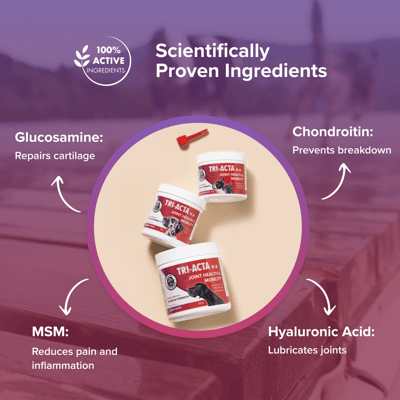
To see a radical improvement in your pet’s joint health, performance, and well-being, you should be looking for a pet supplement containing more than just glucosamine.
The truth is glucosamine works best for your dog when combined with three other powerful ingredients for animal joint health.
These ingredients are:
- Chondroitin
- MSM
- Hyaluronic Acid
- Bone broth
Chondroitin for Dogs
Chondroitin is a naturally occurring chemical in the body, mostly found in joint cartilage. Chondroitin gives cartilage its stretch by keeping it well hydrated. Studies show that the supplement can fight the enzymes that reduce collagen's breakdown in the joints.
When Chondroitin is used in its high-quality form, it can decrease swelling and the hastiness of cartilage and joint breakdown in dogs and humans. Some have said that chondroitin provides more pain relief for joint pain than commonly prescribed NSAIDs or non-steroidal anti-inflammatory drugs, which can cause heart problems.
Chondroitin is traditionally manufactured using cow or shark cartilage but can also be made in a lab. It’s important to note that products that source ingredients from shark cartilage can have significant negative consequences on marine ecosystems, so we recommend avoiding using these products.
What are the Side Effects Of Chondroitin in Dogs?
While most side effects are very mild, some can be severe. You should always consult your vet before trying a new supplement.
Side effects of chondroitin may include:
- Diarrhea
- Rash
- Bloating & gas
- Stomach upset & nausea
Studies have shown that consistent use of glucosamine and chondroitin can reduce inflammation substantially in dogs. Glucosamine with chondroitin for dogs is a potent and beneficial supplement that protects and repairs joints.
MSM for Dogs
MSM is short for Methylsulfonylmethane. It’s a form of sulfur that naturally occurs in animals and plants and has anti-inflammatory properties. Like glucosamine, it is available in a dog anti inflammatory non prescription supplement.
What are the Benefits of MSM For Dogs?
MSM is an essential component of an effective canine joint supplement because it is a powerful natural anti-inflammatory. By reducing inflammation in your dog’s joints, your dog will experience far less pain and, therefore be more likely to:
- Enjoy walks and playtime
- Show that they’re happy
- Be safe from further injury due to compensation
- Have less stress on their immune system
Ensuring your dog’s joint supplement contains MSM will protect your beloved pet from pain and stress while the other active ingredients get to work.
Hyaluronic Acid for Dogs
Hyaluronic acid is a cutting-edge natural ingredient that boosts the efficacy of your dog’s joint supplement.
It’s a clear, viscous liquid that replicates the natural fluid protecting your dog’s joints. Arthritis occurs when the natural-forming HA in your dog’s joints starts to break down.
What Are The Benefits of Hyaluronic Acid For Dogs?
H.A. lubricates the joints as a natural shock absorber. Because of its viscous texture and high bioavailability, a supplement containing H.A. offers the following benefits to your dog:
- Reduces pain associated with arthritis
- Slows the breakdown of cartilage that leads to arthritis
- Prevents further joint damage in older dogs
- Prevents injury
TRI-ACTA H.A. for Pets
Our maximum strength formula is optimally designed to accelerate the formation of cartilage, minimize inflammation, expedite the healing process, and improve joint conditions.

Bone Broth for Dogs

Humans have been making bone broth for centuries because of its apparent health benefits, specifically for strengthening the kidneys and liver. Given the fact that bone broth seems to be good for humans, it makes sense that dog owners would wonder if giving it to their dog could provide their furry friend with the same benefits.
Adding bone broth to your dog's diet can offer multiple health benefits due to its rich content of nutrients and beneficial compounds that are similar to a pet probiotic. Here's a breakdown of the advantages:
- Liver support: Dogs naturally explore their environment using their mouths and noses, which can lead to the ingestion of harmful substances. Bone broth supports liver function, as it is rich in amino acids like glycine that help the liver process and eliminate toxins.
- Immune system boost: Bone broth contains vital nutrients such as collagen, gelatin, glycine, glucosamine, glutamine, and electrolytes, which are crucial for maintaining a robust immune system. A strong immune system enables your dog to better resist diseases and reduces hypersensitive reactions.
- Digestive health: For dogs with sensitive stomachs, bone broth can be soothing, especially during episodes of gastrointestinal distress. It provides antioxidants that help balance gut flora, alleviate symptoms, and enhance digestive processes.
- Healthy skin and coat: Ingredients like collagen in bone broth are essential for skin and fur health. Collagen levels may decrease as dogs age, but bone broth can supplement this nutrient, promoting a shiny, healthy coat.
- Joint strength: Although bone broth isn't a cure-all for joint issues, it's a beneficial addition to diets that include joint supplements like TRI-ACTA. The natural glucosamine found in bone broth supports joint health, and any excess is harmlessly processed by your dog’s body, with the only mild potential side effect being gastrointestinal upset.
- Hydration and appetite enhancement: Bone broth can be particularly hydrating when mixed with your dog’s regular food, providing necessary moisture for hydration—important for older dogs or those with kidney or urinary tract issues. Its appealing taste can also help stimulate appetite in dogs that may be hesitant to eat.

Identifying the Best Glucosamine for Dogs Supplements
Choosing the best glucosamine supplement for your dog involves considering several factors, including the form of glucosamine, additional ingredients for joint health, and your pet's specific needs. Here are some considerations to keep in mind before we get into our recommendations.
Price Versus Ingredients
Top companies producing joint supplements for dogs will provide a comprehensive list of all ingredients, including the amounts of active ingredients per dose. Understanding how to interpret supplement labels is crucial, as it allows you to easily compare various products once you know what key information to look for.
In general, you should be looking for canine joint supplements that contain these active ingredients:
|
Active Ingredient in Dog Joint Supplements |
Active Ingredient in Dog Joint Supplements |
|
Glucosamine Sulfate / Glucosamine HCl |
Glucosamine sulfate delivers sulfur to your dog's joints, a crucial element for maintaining and repairing joint structures. On the other hand, Glucosamine HCl is a highly bioavailable form of glucosamine, allowing for quicker and easier absorption by your dog's body. Consequently, your dog's joints may experience enhanced lubrication and protection more rapidly. |
|
Chondroitin |
Glucosamine and chondroitin together promote cartilage repair and help prevent cartilage degradation in your dog’s joints. |
|
MSM |
A natural anti-inflammatory, MSM reduces swelling in your pup’s joints, relieving pain and allowing for easier movement. |
|
Hyaluronic Acid |
Increases the viscosity of the synovial fluid in your pup’s joints, allowing easier movement with less friction. |
These are called active ingredients because they provide a direct therapeutic effect for your dog. However, many joint supplements for dogs also contain additional ingredients that don’t have therapeutic benefits, which are referred to as inactive ingredients:
|
Inactive Ingredient in Dog Joint Supplements |
Effect |
|
Fillers |
These substances are often used to increase the volume of the supplements. In addition to being unnecessary for a good supplement, they are often substances such as talc, which are barely considered edible. |
|
Sugars |
These simple carbohydrates are unnecessary additives that can cause health problems such as obesity, heart, and liver conditions. |
|
Preservatives |
Preservatives are extra substances added to foods and supplements in order to make them last longer in storage. |
|
Artificial Colors |
The chemicals used to fabricate these colours are unnecessary and can be carcinogenic. |
The active ingredients in each dose can be easily calculated by looking at the product’s recommended dosage. For example, if the product says that each 1g (1000mg) dose contains 500mg of glucosamine and 250mg of chondroitin, it means that 250mg of that dose contains inactive ingredients.
This is also important when determining price—a supplement with a higher price point may turn out to give you more bang for your buck because dosages are lower due to more active ingredients.
Designations and Third Party Testing
In today's online shopping landscape, it's all too easy to end up with a product that doesn't meet expected quality standards. To avoid disappointment, make sure the supplement you choose clearly displays indicators of high-quality ingredients. For instance, top-quality supplements for dogs manufactured in Canada should carry the Veterinary Health Product (VHP) designation near the barcode on its label. This label ensures the product is crafted from dependable, batch-tested ingredients that are scientifically proven to effectively support joint health in dogs.

Packaging and Usability

Packaging and how the dosage is administered is another important point to consider. You want to take into account:
- How is it packaged?
- Can I store it easily?
- Does it need refrigeration?
- How do I administer the supplement?
Some manufacturers require their supplements to be refrigerated to keep them fresh, while others are shelf-stable for a period of time. Others can be stored according to personal preference.
We also took into account the manner in which the canine joint supplement can be administered. Some supplements aren’t exactly tasty to dogs—especially if you have a picky eater. Most dog supplement manufacturers try to remedy that by providing chewable flavoured tabs, but as many dog owners know, this doesn’t always work.
Some forms that dog supplements come in are:
- Powders
- Liquids
- Capsules
- Chewable tabs
Supplements that make it much easier to administer, even to the pickiest of eaters, are more desirable and create less hassle on your end.
Administration and Shelf Life
Dog joint supplements come in a variety of forms, including:
- Powder: Dog supplement powder is usually flavourless, but can sometimes come in flavours like beef or chicken. Powders are usually the easiest to administer because they can be mixed in wet food with little to no effect to the texture.
- Liquid: These supplements for dogs might be unflavored or flavored to enhance palatability. Although liquid supplements can be conveniently added to both wet and dry dog food, applying them to dry food can make the kibble soggy, potentially deterring your dog from eating it.
- Capsules: These are almost always flavourless, but they often need to be hidden in a treat to get your dog to take it willingly. Capsules have a long shelf-life similar to powder.
- Chewables: Often masquerade as a dog treat by coming in various flavours and textures (soft or crunchy). It may take some trial and error to determine which flavour of chewable dog joint supplement your pup prefers.
Buying dog joint medicine in bulk can be a good strategy to maximize cost-effectiveness, but it's important to consider the shelf-life and storage requirements of the products you choose.
Capsules and powders generally have a longer shelf life and are simpler to store because they are dry; they can be easily kept in a cupboard or on a shelf. In contrast, chewables and liquids have a shorter shelf life. High moisture content in these products can lead to quicker deterioration and the potential for bacterial growth. While many of these can be stored in a cupboard or on a shelf, some may require refrigeration.
When managing veterinary medications, including supplements, a few general rules are crucial:
- Potency loss after expiry: Using supplements past their expiration date can reduce effectiveness, meaning your dog might not get the full benefit.
- Risk of mold or bacteria: Expired supplements, particularly chewables and liquids, are prone to developing mold or bacteria due to ingredient breakdown.
- Longevity of capsules and powders: Capsules and powders typically last the longest, up to three years, if stored properly in a cool, dry place.
Testimonials from Veterinarians and Reputable Pet Owners
With the increasing demand for glucosamine mobility supplements, especially at cheaper prices, companies are cropping up left and right—and not all of them are reputable.
You want to purchase from a company that’s reputable and has been in business for a number of years. They should be solely focused on the health of your beloved pet and one of the best ways of doing this is by checking out if there are multiple positive reviews of the effectiveness from reputable veterinarians and trainers along with unsponsered pet owners.

Limiting Side Effects and Allergic Reactions
When a dog supplement is of the highest quality, there should be no significant side effects. Checking on the prevalence of side effects of each and every company you consider is important, especially if your pup has known allergies or is a sensitive senior. They’re already in a more fragile health bracket, so limiting any potential strain is crucial to their overall health.
Before starting any supplement regimen, you want to make sure to consult with your veterinarian first. This would be the case especially if your pup is on any medications. You want to make sure there will be no undesirable or potentially dangerous interactions with any ingredients.
A good way to further limit side effects is by avoiding unecessary fillers in your supplements.
Customer Service and Post Sale Support
What happens when you have questions after the purchase? Does the customer service experience end after you’ve received your supplement?
The best dog supplement manufacturers also have the best customer support. Should you have questions, you want to make sure your chosen company will care enough to support you and your dog throughout the life of using their product.
They should be available to speak with you either via phone or email without unreasonably long waiting times, and with the greatest of care and concern. You can usually get a pretty good idea of this from online reviews.

The 5 Best Glucosamine For Dogs Recommendations
With all of the options for glucosamine and chondroitin pet supplements, available on the market, how do you know which ones to choose?
We’ve compared Integricare’s high-quality TRI-ACTA and TRI-ACTA H.A. with three other brands also offering glucosamine chondroitin for dogs in a variety of other supplement forms. In this comparison study, we will consider how they stack up to the competition and why you should give TRI-ACTA a second look.
Best Glucosamine for Dogs Overall: TRI-ACTA H.A.

Formulated to offer the best in joint health support, helping dogs that are at higher risk for joint issues or are already suffering with problems like arthritis and joint degradation. Manufactured under strict quality control and third-party tested, TRI-ACTA H.A.’s ingredients don’t contain one but two forms of the highly valuable amino sugar, glucosamine.
Active ingredients: Glucosamine HCl, Glucosamine Sulfate, Methylsulfonylmethane (MSM), Chondroitin Sulfate, and Hyaluronic Acid—that’s it, no fillers!
Because there are no fillers, the servings are small (often less than 1 gram), and all three options provide great cost per serving, ranging from $0.27 cents to $0.46 cents. And again, with zero fillers, the cost per active ingredient is among the industry's best. Besides the Integricare website, it can also be purchased at local retailers.
Some of the pickiest eaters won’t even take a second look at a soft chew or chew tab—no matter what flavour it is. And crushing tablets can be such a hassle. Because of the purity and concentration of TRI-ACTA H.A., the servings are extremely small and easy to administer. You don't have to give a lot, but you get therapeutic levels of the active components because of its concentration. This product comes in a powder form that is easy to administer and mix into the food of even the pickiest eater, no matter how finicky they are.
TRI-ACTA H.A. for Pets
Our maximum strength formula is optimally designed to accelerate the formation of cartilage, minimize inflammation, expedite the healing process, and improve joint conditions.

* TRI-ACTA H.A. comes in 3 sizes—60 g, 140 g, and 300 g, and ranges in price from about $27.99—79.99 CAD. Pricing as of April 2024.
Best Glucosamine Capsules: G-Max Joint Support

Manufactured by PawLabs, G-Max Joint Support is a joint supplement that highlights their use of 8 key ingredients. These featured ingredients are used to aid in supporting the health and well-being of dog joints.
Active ingredients: Glucosamine, MSM, Turmeric, Chondroitin, Calcium Carbonate, Hyaluronic Acid, Beef Liver, Vitamin C
It comes in bottles of 60 flavoured tablets, each bottle retailing for about $81.99 CAD*. It’s a shelf-stable supplement but must be stored in a cool, dry place. G-Max Joint Support is available through their website only, and rush shipping is available for a fee.
PawLabs prides themselves on doing clinical research and manufacturing their products in an FDA-approved facility. Vets and customers agree that the supplement is beneficial. However, there is little to no indication of post-purchase support or customer service.
* Pricing as of April 2024
Best Glucosamine Chews: Zesty Paws Mobility Bites

A joint supplement featured by manufacturer ZestyPaws, Mobility Bites are designed to promote joint health. They do this by encouraging the body to keep the joints lubricated, thereby creating more resiliency.
Active ingredients: Glucosamine HCl (shellfish sourced), OptiMSM, Ascorbic Acid (Vitamin C), Chondroitin Sulfate (porcine source), Kelp, Vitamin E
A standard container comes with 90 soft chews that are either Duck or Bacon flavoured. These chews retail for $40.99 CAD*, and are available via the ZestyPaws website and Amazon.com.
While their active ingredients are of decent quality, they also include a variety of inactive ingredients—some of these being fillers such as cellulose and flour. They have several ways to reach customer service should you have questions. Customer reviews, however, are mixed.
* Pricing as of April 2024
Best Glucosamine Liquid: Ultra Oil All Natural Joint Pain Supplement

Ultra Joint, a new joint supplement from Ultra Oil—a company traditionally known for its skin and coat products for pets—features a robust formula.
Active ingredients: 426mg of glucosamine sulfate, 320mg of MSM, 106mg of chondroitin, and 13mg of hyaluronic acid
Ultra Joint contains several other components, such as ginger extract, beef collagen, Boswellia serrata extract (also known as Indian frankincense, noted for its anti-inflammatory effects), manganese gluconate (which supports tissue development), and peanut butter. It's important to be aware of these additional ingredients, especially if your pet has allergies.
* The bottle comes in a 236 ml to 946 ml size, ranging in price starting at $23.99 to $54.39 CAD. Pricing as of April 2024.
Best Proactive Glucosamine Powder: TRI-ACTA

When it comes to proactive joint support for your dog, our regular strength TRI-ACTA formula provides everything your puppy or adult dog needs—glucosamine, chondroitin, and MSM— to maintain their joint health. Just like our maximum strength H.A. formula, TRI-ACTA is manufactured under strict quality control conditions and contains two types of glucosamine.
Active ingredients: Glucosamine HCl, Glucosamine Sulfate, Methylsulfonylmethane (MSM), Chondroitin Sulfate (no fillers!)
TRI-ACTA is a perfect joint support supplement for puppies or adult dogs that don’t yet have joint issues, but that you want to give extra support to as they continue to grow. After all, prevention is key for mitigating the chances of serious joint problems down the road.
TRI-ACTA for Pets
A proactive approach for developing and younger adult pets to maintain optimal joint health mobility, minimize inflammation and fend off age-related ailments.

* TRI-ACTA comes in 3 sizes—60 g, 140 g, and 300 g, and ranges in price from about $23.99—64..99 CAD. Pricing as of April 2024.

Considerations With Glucosamine In Dog Nutrition
We can’t help but preach the remarkable benefits of glucosamine for dogs. The powerful ingredient repairs the cartilage protecting your pet’s joints and has anti-inflammatory properties to ease pain and boost mobility. Glucosamine works best when paired with other ingredients, such as Chondroitin, MSM, and hyaluronic acid, to alleviate joint pain.
Glucosamine Dog Food
You may be familiar with some dog food and treat brands advertising their products as dog food for joint health, calling out ingredients like glucosamine and chondroitin, and sometimes MSM so that they can say that it is an anti-inflammatory dog food option.
While these two ingredients are wonderful for joint dog health, the dosage per serving size in dog food is minimal compared to actual joint supplements. This means that the majority of the time, the supplemental level in the food isn’t enough to have any therapeutic effect.
Most top glucosamine dog food brands will contain around 540–1000 mg/kg of glucosamine. But it’s important to realize that this amount is not per serving, but per kg of food (approx. 4 cups). As a result, you’d have to feed your dog several kg’s of food at one time in order to get any therapeutic value from it. Plus, most of the efficacy of the glucosamine is usually lost during the cooking and processing of the food.
Glucosamine Dog Treats
Similar to glucosamine dog food, glucosamine dog treats are an attractive option for dog owners because they look and taste like normal treats but have the benefit of glucosamine and other joint support ingredients inside them. Often these come in a convenient “chew” format.

However, just like glucosamine dog food, dog treats with glucosamine rarely have enough therapeutic ingredients to have a positive effect on your dog’s joint health. Plus, treats often have fillers, additives, and preservatives, so you’re giving your dog a number of extra calories and useless ingredients with each dose.
It’s much better to give your dog an actual joint supplement in addition to their food rather than food with supplemental ingredients incorporated into it.
The best supplements contain these four key ingredients for joint health:
- Glucosamine: repairs cartilage
- Chondroitin: prevents cartilage deterioration
- MSM: reduces pain and inflammation
- Hyaluronic acid: lubricates joints
In reality, the best dog food for joint health is any nutritious dog food or diet combined with quality joint supplements. Powder supplements like TRI-ACTA can easily be mixed with wet food or dry kibble and disguised to fool even the pickiest eaters.
TRI-ACTA for Pets
A proactive approach for developing and younger adult pets to maintain optimal joint health mobility, minimize inflammation and fend off age-related ailments.


Glucosamine and Chondroitin for Dogs by Age
When considering glucosamine and chondroitin supplements for dogs, tailoring the supplement to the dog’s age is important as their joint health needs change over their lifespan.
Glucosamine for Proactive Puppy Care
 Glucosamine for proactive puppy care can play a crucial role in promoting long-term joint health from an early age, especially for breeds that are predisposed to joint issues like hip dysplasia or arthritis.
Glucosamine for proactive puppy care can play a crucial role in promoting long-term joint health from an early age, especially for breeds that are predisposed to joint issues like hip dysplasia or arthritis.
Here’s a breakdown of how glucosamine can be beneficial in puppy care, and what to consider when incorporating it into your puppy’s regimen:
Benefits of Glucosamine for Puppies
- Joint development: Glucosamine is a natural compound found in healthy cartilage. Supplementing with glucosamine can help support the development of strong, healthy joint cartilage, which is vital as puppies grow rapidly.
- Preventive care: Starting glucosamine supplements early can help prevent the degradation of joint tissues and support overall joint health, potentially reducing the risk of joint-related problems as the dog ages.
- Support during growth phases: Large breed puppies, which grow quickly, can particularly benefit from glucosamine to help manage the stress on their joints due to rapid growth.
When to Start Glucosamine for Puppies
- Consult a veterinarian: It’s essential to consult with a veterinarian before starting any supplements. They can advise on the appropriate age and dosage based on the breed, size, and growth rate of your puppy.
- Breed and size considerations: Generally, puppies might not need glucosamine supplementation until they are at least a few months old, but for larger breeds, starting earlier may be recommended due to their quicker growth rates and higher susceptibility to joint issues.
Choosing the Right Glucosamine Supplement
- Formulated for puppies: Look for glucosamine supplements specifically formulated for puppies. These are generally milder and tailored to support a growing dog’s needs.
- Quality and safety: Choose high-quality, well-reviewed products from reputable brands. Products should be free from harmful additives and appropriate for the dietary needs of puppies.
- Ingredient combinations: Some glucosamine supplements for puppies also include chondroitin and MSM, which work synergistically to enhance joint support and overall health.
Administration and Dosage
- Dosage guidance: Follow veterinarian guidance on dosage to avoid over-supplementation, which can be harmful. The dosage usually depends on the puppy’s weight and growth stage.
- Easy to administer forms: Puppy-friendly forms of glucosamine include chewable treats or liquids that can be mixed into food, making it easier to administer without stress.
By incorporating glucosamine into your puppy's healthcare regime, you can help ensure they develop strong, healthy joints that will support their active lifestyles as they grow into adulthood. Always keep in touch with your vet to adjust the supplement as your puppy grows and their needs change.
Glucosamine for Senior Dog Care

Glucosamine plays a vital role in managing joint health, especially for senior dogs who are more prone to experiencing joint pain, stiffness, and other mobility issues such as arthritis. Incorporating glucosamine into the care regimen of an older dog can significantly enhance their quality of life.
Here's a guide on how to use glucosamine for senior dog care:
Benefits of Glucosamine for Senior Dogs
- Pain relief: Glucosamine helps alleviate joint pain and discomfort by supporting the repair of damaged cartilage and maintaining the lubrication needed for joint movement.
- Improved mobility: Regular supplementation can lead to improved mobility, allowing senior dogs to maintain a more active lifestyle and manage their weight, which is crucial for reducing joint stress.
- Anti-inflammatory properties: Glucosamine also has anti-inflammatory effects that help reduce the swelling and soreness associated with joint degeneration.
When to Start Glucosamine for Senior Dogs
- Early intervention: It’s beneficial to start glucosamine supplementation before your dog shows significant signs of joint distress. However, it’s never too late to start, as glucosamine can still provide comfort and support even in advanced cases of joint deterioration.
- Veterinary advice: Always consult with a veterinarian for a proper assessment and to determine the right glucosamine formula and dosage for your senior dog's specific health needs.
Choosing the Best Glucosamine for Senior Dogs
- High dosage and enhanced formulas: Supplements formulated specifically for senior dogs often contain higher levels of glucosamine and may include other joint-supportive ingredients like chondroitin, MSM, and hyaluronic acid, which work together to enhance joint function.
- Quality and safety: Opt for high-quality, reputable brands that provide clear labeling and sourcing information. Supplements should ideally be certified for safety and efficacy by independent testing.
Administering Glucosamine
- Palatable forms: Senior dogs may have particular dietary preferences or sensitivities. Look for supplements in forms that are easy for them to consume, such as soft chews, powders, or liquids that can be mixed into their food.
- Consistent administration: For best results, glucosamine should be given consistently as part of your dog’s daily routine. Regular administration helps maintain steady levels of the supplement in the body, providing ongoing joint support.
Monitoring and Adjustment
- Regular check-ups: Monitor your senior dog’s response to the supplement with regular veterinary check-ups. Adjustments may be necessary over time to adapt to their changing health needs.
- Watch for side effects: While glucosamine is generally safe, it’s important to watch for any signs of gastrointestinal upset or allergic reactions, especially if your dog is taking other medications.
By thoughtfully integrating glucosamine into your senior dog’s care plan, you can help mitigate the impacts of aging on their joints, enhancing their comfort and mobility as they continue to age gracefully.

Common Dog Glucosamine FAQs
Is it Safe to Combine Glucosamine with Dog Inflammation Medicine?
While NSAIDs are effective in managing pain, they can also pose significant risks. Long-term use of NSAIDs in dogs may lead to serious side effects such as liver and kidney damage, ulcers, and gastrointestinal distress, which can vary from mild to severe. These risks are particularly heightened in dogs with pre-existing conditions affecting the kidney, liver, or stomach, and any impairment to kidney and liver function can be potentially life-threatening.
Due to these concerns, many pet owners seek safer alternatives for managing their dog's joint issues without the adverse effects associated with NSAIDs. This has led to the popularity of dog joint inflammation medication or supplements.
 Joint supplements are favored because they contain natural ingredients like glucosamine, chondroitin, Methylsulfonylmethane (MSM), and in some formulations, hyaluronic acid. These compounds are naturally produced by the body, making supplements a way to enhance what the body already makes, aiding in joint repair and protection. The most common side effect of joint supplements is mild gastrointestinal upset, which typically subsides over time and can be minimized by administering the supplements with food.
Joint supplements are favored because they contain natural ingredients like glucosamine, chondroitin, Methylsulfonylmethane (MSM), and in some formulations, hyaluronic acid. These compounds are naturally produced by the body, making supplements a way to enhance what the body already makes, aiding in joint repair and protection. The most common side effect of joint supplements is mild gastrointestinal upset, which typically subsides over time and can be minimized by administering the supplements with food.
However, it's important to note that joint supplements do not provide immediate relief. They usually require consistent daily administration for about four weeks before improvements are noticeable. Therefore, some pet owners initially use a combination of NSAIDs and joint supplements. Over time, as the supplements begin to take effect, the NSAID dosage can often be decreased and eventually discontinued as the supplements alone suffice to manage joint pain and support.
Can I use Human Glucosamine and Chondroitin for Dogs?
Human and canine joint supplements share many similarities, especially in terms of their active ingredients, but there are several important differences on why dogs cannot take human glucosamine.
1. Formulation Differences
- Ingredients: Both human and canine joint supplements typically contain glucosamine, chondroitin, and MSM. However, canine formulas may also include ingredients specifically beneficial for dogs, such as omega fatty acids for skin and coat health, or additional vitamins and minerals tailored to canine health needs.
- Dosage: The concentration of active ingredients can differ significantly. Supplements designed for humans often have higher dosages that may not be suitable for dogs. Conversely, canine supplements are formulated to provide the correct dosage for dogs based on their weight and size.
2. Safety and Tolerability
- Additives and fillers: Canine supplements may avoid certain fillers and additives that are commonly found in human supplements but could be harmful or less tolerated by dogs. For example, xylitol, a common sweetener in human glucosamine supplements, is toxic to dogs.
- Flavouring: Canine supplements are usually flavored to make them more appealing to dogs, such as with beef or chicken flavor, whereas human supplements may not have such specific flavor considerations.
3. Regulatory Standards
Human glucosamine supplements are regulated differently than pet supplements. In the U.S., for example, human dietary supplements are regulated by the FDA under different guidelines than those for pets. Canine supplements fall under pet food regulations, which can vary in strictness and oversight.
4. Form and Ease of Administration
Canine joint supplements may come in forms that are easier for pet owners to administer to their dogs, such as chewable tablets, powders that can be mixed into food, or even liquids. Human supplements typically come in pills, capsules, or powders designed for human consumption preferences.
When choosing a joint supplement for a dog, it's important to select one specifically designed for canines to ensure safety, efficacy, and palatability. Similarly, humans should use supplements designed for human use to meet specific nutritional requirements and safety standards.
What is the Recommended Glucosamine for Dogs Dosage?
The optimal dosage of glucosamine for your dog depends largely on their weight. In general, heavier dogs need a bigger dose of glucosamine compared to a smaller dog. how much glucosamine for dogs is appropriate can vary depending on the supplement itself and the amount of active ingredients (actual glucosamine) that are in a typical dose, but general glucosamine dosage guidelines for dogs are as follows:
- Dogs less than 25 lbs (11 kg): 250–500 mg
- 25 lbs to 50 lbs (22 kg): 500 mg
- 50 lbs to 90 lbs (40 kg): 1,000 mg
- 90+ lbs (40+ kg): 1,500 mg
Note many supplement options may have a larger serving size, trying to combine many things from greens and tomatoes to fillers, flours, and everything in between. But these additional products can be much more costly to get to a therapeutic dosage and result in a significant serving size that a picky eater likely isn't going to touch. Then you've wasted both food and supplement.
What Are Glucosamine for Dogs Side Effects?
To keep your canine companion safe, it’s important to be aware of the common misconceptions of glucosamine in pet supplements and some side effects occur if you choose a product from an untrustworthy or unregulated source. Unregulated pet supplements can have ingredients that aren’t listed on the bottle, which can cause a variety of negative symptoms in your pet.
Watch out for the following side effects that can occur if you give your dog glucosamine:
- Allergic reaction
- Fatigue
- Bloody diarrhea
- Dehydration
- Nose bleeds
- Lameness
- Insomnia
- Excessive thirst or urination
It’s important to pay close attention to your dog’s behaviour when you start administering glucosamine. Take note of anything strange, watch out for patterns, and share this information with your vet.
Serious Side Effects (usually associated with fillers and other additives)
With such a vast array of dog glucosamine products available on the market, it goes without saying that not all of these canine supplements are equal in terms of their effectiveness and quality.
Unfortunately, products from countries with little to no regulation around pet supplements pose a huge threat to your dog’s health.
Watch out for the following serious side effects associated with low-quality, unregulated glucosamine supplements:
- Lead poisoning from products made in China
- Poisoning from synthetic sweeteners
- Kidney failure
The best way to avoid these serious side effects is to choose a pet supplement from a reputable company that is designed, made, and tested in Canada.
With that being said, if you give your dog glucosamine from a safe and reputable company, the chances of your dog developing serious side effects is extremely rare. Your dog would have to consume a large amount of glucosamine at one time to experience anything life-threatening. Even so, the most common symptoms of too much glucosamine for dogs are diarrhea and vomitting, which are usually short-lived.
Where Can I Get Quality Canine Glucosamine Supplements?
Glucosamine supplements for dogs vary greatly, and it can be tough to pick from the hundreds that are out there.
Here are a few things to consider when seeking a glucosamine supplement for your dog.
- The active ingredients: glucosamine, chondroitin, and MSM.
- Serving size—the smaller, the better for these choosy pets.
- Meaningful yet straightforward ingredients—you probably don't need every vitamin under the sun in your dog's supplement.
Your dog gets vitamins from the nutritious and healthy foods you feed them. Taking up space with a bunch of unnecessary ingredients is just for show. Don't bother.

Glucosamine for Dogs Conclusion
There you have it. We’ve provided everything you need to know to protect your pup’s joints against future damage and ensure they live their life to the fullest well into their senior years.
With the help of a powerful canine glucosamine supplement, even your senior dog can start to regain the spring in their step when they hear that magic word—walk!
At Integricare, we’re committed to delivering dog owners only the very best glucosamine supplement for dogs. We’re proud to provide pharmaceutical-grade ingredients in a potent formula designed for maximal ingestion and minimal stress on your pocket!
We’re also here to help and answer any questions you might have about glucosamine for your dog and how to help protect them from joint problems and reduce the symptoms of mobility conditions.
Just contact us, and our friendly team of animal lovers will be right with you.
TRI-ACTA H.A. for Pets
Our maximum strength formula is optimally designed to accelerate the formation of cartilage, minimize inflammation, expedite the healing process, and improve joint conditions.


